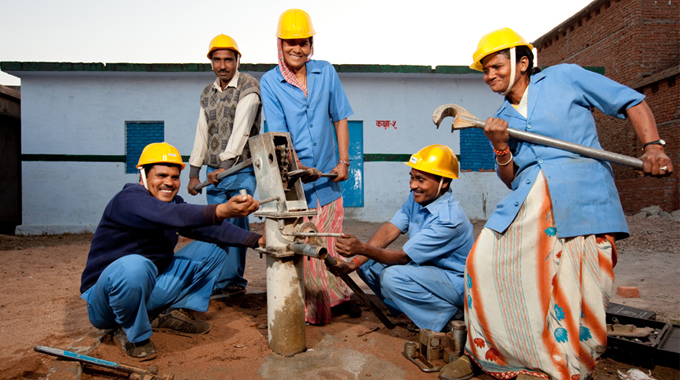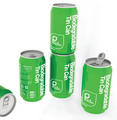Future Perfect: Sustainable biofuels made from algae
by: Ecofriend, 2011-02-25 02:28:56 UTC
Garima_goel:

What’s happening right now?
Declining global oil productive capacity combined with a growing oil demand in developing countries provides the most compelling global reason for alternative fuels. The current strain on petroleum supply has pushed petroleum product prices up. On the oil supply side, there are no major undiscovered oil reserves which can significantly add to global supply. Moreover, man-made emissions, particularly from the burning of fossil fuels, are contributing to environmental pollution and hence resulting in global climate change.
Biofuels are gaining increased public and scientific attention, driven by factors such as oil price spikes, the need for increased energy, and concern over greenhouse gas emissions from fossil fuels. The production of biofuels from algae could be a meaningful part of the solution in the future because of its potential as an economically viable, low emissions transportation fuel.
TRENDS
1. Aquaflow and Solray’s joint venture to convert algae into biofuel
New Zealand algae-to-biofuel hopefuls Aquaflow Bionomics and Solray Energy have teamed up to see if they can overcome the challenges that have kept algal biofuels from commercial production to date. The partnership will combine Aquaflow’s methods of harvesting algae grown from wastewater streams and Solray’s process of turning that algae into fuel. Their work will target global demand for clean water, reduction of nitrogen and phosphates which have seriously degraded aquatic ecosystems, and renewable biofuels from waste.
2. Biodiesel
Algae may be the miracle element in the search for a more environmentally-friendly, mass-produced product that can be converted into fuel. Algae grow naturally all over the world. Under optimal conditions, it can be grown in massive, almost limitless, amounts and their growth rate than other crops. Scientists have been studying algae’s lipid oil for decades to convert it into algae biodiesel — a fuel that burns cleaner and more efficiently than petroleum. Algae are excellent bioremediation agents - they have the potential to absorb massive amounts of CO2 and can play an important role in sewage and wastewater treatment.
3. Biobutanol
Butanol can be used in gasoline engines without engine modification. It is a promising fuel that can be used instead of ethanol and methanol. The energy density of butanol is 10% less than gasoline but more than that of either ethanol or methanol. Butanol is less corrosive and hence can be more easily transported over pipes.Diatoms or algae can be used as the raw organic material for butanol production which can be powered by 100% solar energy. Butanol is prepared by the green waste that is left over after the production of oil from algae.
4. Biogasoline
Biogasoline is a gasoline produced from biomass such as algae, crops, and animal fats. It is chemically different from the gasoline we know today, which is alcohol. Biogasoline is actually hyrdrocarbons containing 6 (hexane) to 12 (dodecane) carbon atoms per molecule. It is very similar to gasoline and 100% biogasoline will actually work in a modern gasoline engine as a drop-in substitute for petroleum gasoline.
5. Methane
Methane, in a blend of other gases, can be produced from biomass by a biochemical process called anaerobic digestion and can be utilized to replace energy derived from fossil fuels, and hence reduce emissions of greenhouse gasses.The production of methane from algae is usually not a one-step process. It requires the manipulation of a set of bioreactions beginning with the treatment of algae as simply sources of cellulose, with the object of maximizing the output of acetic acid and acetates which are then subjected to methanogenic reaction to produce methane. Methane in the form of compressed natural gas is used as a vehicle fuel, and is claimed to be more environmentally friendly than fossil fuels such as gasoline/petrol and diesel.
The concept:
Researchers at Rochester Institute of Technology are developing biodiesel from microalgae grown in wastewater. The project is doubly “green” because algae consume nitrates and phosphates and reduce bacteria and toxins in the water. The end result is clean wastewater and stock for a promising biofuel. The purified wastewater can be channelled back into receiving bodies of water at treatment plants, while the biodiesel can fuel buses, construction vehicles and farm equipment. Algae are much simpler organisms using photosynthesis to convert sunlight into energy. They need only water of ponds or tanks to grow in sunlight and carbon dioxide.
The production of algae has been increased from 30 gallons to 100 gallons and hopes to expand to 1,000 gallons by spring, as the team from the Environmental Energy Technologies hopes algae to be the fuel of the future.
The advantages:
There are many advantages to this approach over using food crops to produce fuel. Algae must be grown in tanks. These tanks can be put anywhere where there is a lot of sunlight and this does not impact on the amount of available farming land. The other major advantage is that algae reproduce far more quickly than crop plants and do not require fertilizers for their growth.
Useful algae can be grown in sea water so there is no need to use precious drinking water to grow the fuel. Algae Oil Extracts can be used as livestock feed and even processed into ethanol. The yield of vegetable oil from algae is comparatively much higher (about 30 times) than land crops.
Algae have the highest rate of consumption of CO2 out of every known plant. When the algae are being produced it actually requires CO2 as an input to grow instead of the huge output of CO2 produced by the burning of petroleum products. Algae biodiesel has virtually no sulphur content. It is non-toxic, highly biodegradable and this biofuel can be used in gasoline engine without varying the engine.
The impact:
Algae fuel is an alternative to fossil fuel and uses algae as its source of natural deposits. Several companies and government agencies are funding efforts to reduce capital and operating costs and make algae fuel production commercially viable. The biofuel produced from algae amounts to a minimal reduction of CO2 as the CO2 consumed by the algae is returned to the atmosphere when the biofuel is burned.
As an environmentally sustainable alternative to current algae production methods, the researchers propose situating algae production ponds behind wastewater treatment facilities to capture phosphorous and nitrogen which are essential nutrients for growing algae. Those same nutrients are discharged to local waterways, damaging the water bodies.
While the researchers found algae production to have a greater environmental impact than other sources, it remains an attractive source for energy. Algae, which are grown in water, don’t compete with food crops grown on land and also tend to have higher energy yields than sources such as corn or switchgrass.
The algae industry can proactively address sustainability issues by conducting and publishing techno-economic and life cycle analyses, water balances, and energy and carbon balances, feasible, adopting low-impact development, operations, and maintenance practices.


 The Asian giants - India and Japan - would collaborate on building 24 green cities!
The Asian giants - India and Japan - would collaborate on building 24 green cities!
by: Ecofriend, 2011-02-27 07:48:10 UTC
Dattatreya:

In a stately declaration on 16th February, the Japanese government unveiled the grand plan of signing free trade agreements with India that is expected to cut off 94% of trade tariffs over the course of 10 years. But most importantly for us, the plan also incorporates the lofty proposition of building 24 green cities, all in India.
The agreement shouldn’t come as much of a surprise, in view of the current economic and socio-political situation prevailing in the South-East Asia region. Japan is the 3rd largest economy in the world and no so far behind India - is the 4th largest, both in terms of purchasing power parity. Moreover, India startling economic growth in the recent years along with its huge market potential makes it more than a deserving candidate. And again politically both these nations would try to tacitly deter the influence of the other Asian giant - China.
But what is rather astounding, is the ambitious scale of this agreement. All the 24 green cities are to be build along the Delhi-Mumbai industrial corridor, spread across 7 states. These advanced urban settlements would integrate the very latest in green energy supplies, an advanced 24 hour water supply system - incorporating water and waste recycling plants, and public recreational zones like walking paths. Moreover, illustrious companies like Hitachi, Mitsubishi, and Toshiba are all expected to take a part in this grandiose project, in effect creating more green jobs. Well for now we just have to wait and see how this ‘brainchild’ takes the optimum advantage of India’s potential and Japan’s expertise.
Image Source: Courtesy of Flickr user Ivan Walsh.
Source: Good


 Drastic New Reduction in Power Conversion Losses
Drastic New Reduction in Power Conversion Losses
by: Eco Geek Latest, 2011-02-26 05:39:15 UTC

What if your laptop no longer needed a converter brick? What if the DC power from your solar panels was converted to AC electricity with virtually no power loss from the conversion? What if the regenerative brakes in electric drive vehicles could put power into the batteries with almost no loss from power conversion? New technology could reduce power conversion losses by an estimated 90 percent.
A company called Transphorm, whose investors include Google Ventures and Kleiner Perkins and which was recipient of a significant ARPA-E grant to develop this technology, is poised to introduce their initial product offerings which can significantly improve power conversion. The technology is based on using gallium nitride instead of traditional components to greatly reduce the energy losses in power conversion.
The technology for these new devices is based on developments for the use of gallium nitride for LEDs. In addition to the significant improvement in efficiency, components made in this fashion would also be lighter than conventional converters.
Not only would this be useful for laptop computers, but many renewable energy production systems such as solar photovoltaics and wind turbines would also see an efficiency improvement of a few percent over current systems. It might not seem like much, but the long term benefits of this, multiplied over billions of devices, could be hugely significant. As the company points out, "More than 10% of all electricity is ultimately lost due to conversion inefficiencies. The scale of this loss exceeds the world's entire supply of renewable generation by an order of magnitude." Even if this company can address all of that, it will still take many years to overcome the current stock of less efficient converters.
via: MIT Technology Review and BoingBoing
 werner aisslinger: yill for younicos
werner aisslinger: yill for younicos
by: Designboom - Weblog, 2011-02-25 09:00:00 UTC

'yill', designed by werner aisslinger for berlin-based renewable energy company younicos, is a cordless energy storage unit designed to facilitate the creation of workspace even in poorly suited environments.
read more
Kaneka to Release Organic LED Panel in March
by: Tech-On! : tech news - straight from Asia., 2011-02-16 15:33:00 UTC
Kaneka Corp announced that it will start accepting orders for its organic LED device March 22, 2011, in Japan and in mid-April in Europe.
PV Battery, Water Heater Combined for Efficiency
by: Tech-On! : tech news - straight from Asia., 2011-02-23 22:26:00 UTC
Nippon Telegraph and Telephone Corp (NTT) prototyped a "cogeneration-type amorphous photovoltaic power generation module" and demonstrated it at NTT R&D Forum 2011, which runs from Feb 22 to 23, 2011, in Tokyo, Japan.
The Adventure Project Brings Clean Water to Indian Villages, With Help From Female Water Mechanics
by: fast company, 2011-02-25 19:35:30 UTC

Broken freshwater wells are rampant in Africa and India; it's problem that causes 4,000 children to die each day due to a lack of clean drinking water. That's why the Adventure Project, a nonprofit that brings attention to a different humanitarian issue each quarter, is currently focusing its attentions on WaterAid, an international NGO that provides clean water to developing countries.
The Adventure Project launched in 2010 with the goal of increasing investment in positive social enterprises around the world. The nonprofit's first campaign, the Coal Project, raised enough cash for 1,730 families in Haiti to receive charcoal-efficient stoves. The Coal Project sold stocking stuffers--$20 boxes of coal--to raise the cash.
As part of this quarter's Keep It Clean campaign, the Adventure Project hopes to raise $22,000 through donations and sales of Keep It Clean soap--enough money to help WaterAid expand its handpump mechanic business in Northern India.
The two year-old business, which trains both male and females, teaches budding mechanics how to fix well handpumps. When a handpump breaks down, villagers call the mechanic shop and someone bikes over to fix it. "With some of the [female] mechanics, their husbands thought it was
inappropriate," says Adventure Project founder Becky Straw. "One woman made so much money that she could help her
husband open a store and help her girls go to school. Now her husband isn't saying
anything anymore about it."
As a side business, some of the female mechanics have started selling sanitary pads to villagers when they bike over to fix wells. This is revolutionary for women in the area, most of whom don't have access to sanitary pads and have to stay home while menstruating.
Next quarter, the Adventure Project plans to turn its attention to agriculture. And after that, the nonprofit hopes to support textile workers in Malawi. "Taking social enterprise to a different population is really important for us," says Straw.
Photo Credit: Esther Havens
Follow Fast Company on Twitter. Ariel Schwartz can be reached by email.


 Americans Twice as Contaminated With Toxic BPA As Canadians
Americans Twice as Contaminated With Toxic BPA As Canadians
by: Chemistry, 2011-02-23 19:58:10 UTC
Despite eating the same foods and using the same products that contain bisphenol A (BPA), people in the United States have twice as much of the gender-bending chemical in then than Canadians.
 Happy feet with Invisible Shoes
Happy feet with Invisible Shoes
by: The Design blog, 2011-02-24 23:39:46 UTC
Sahilkh18:

Leaving far behind Cinderella’s glass shoes are Brazilian designer Andreia Chaves “Invisible Shoes.” Launched formally at the Mercedes-Benz Fashion Week, Andreia’s first commercial studio collection is inspired from the concept of invisibility and use reflective surfaces to create a chameleon effect. The shoes blend with the surrounding as smoothly as possible while at the same time providing ultimate comfort to your feet.
Great pains are taken while preparing the design of each pair of shoes. Being initiated in Italy, they are prepared using the finest possible leather making techniques coupled with the latest 3D printing technology. Available in 3 models, these shoes would be available at a store near you very soon.



Via: design-milk


 A Win-Win for Biodiversity and Biofuels
A Win-Win for Biodiversity and Biofuels
by: Eco Geek Latest, 2011-02-17 22:07:45 UTC

Studies by researchers at Michigan State University indicate that using grasslands can be useful for biofuel stock as well as helping protect bird species.
Much of the current domestic ethanol production is corn based, although there are numerous criticisms against this approach. Cellulosic methods such as using prairie grasses for ethanol production do not produce 'food-or-fuel' conflicts, and can be equal or better yielding feedstocks for the process than corn or sugar. And, according to MSU biologist Bruce Robertson, using grasslands to produce biofuel feedstock would also provide habitat for a more diverse population of birds.
"Robertson and colleagues found that bugs and the birds that feed on them thrive more in mixed prairie grasses than in corn. Almost twice as many species made their homes in grasses, while plots of switchgrass, a federally designated model fuel crop, fell between the two in their ability to sustain biodiversity."
Converting even more land over to undifferentiated monoculture crops for biofuel is likely to be a short-sighted decision, and could lead to further decline of bird species. Developing methods to make fuel by using diverse grasslands could be doubly beneficial, aiding the protection of bird species as well as providing a more carbon sensitive alternative for producing fuel.
image: Matt Sileo/MSU
via: MSU News











Comments by our Users
“It is a great way to change over nutrients of waste water in fuel”